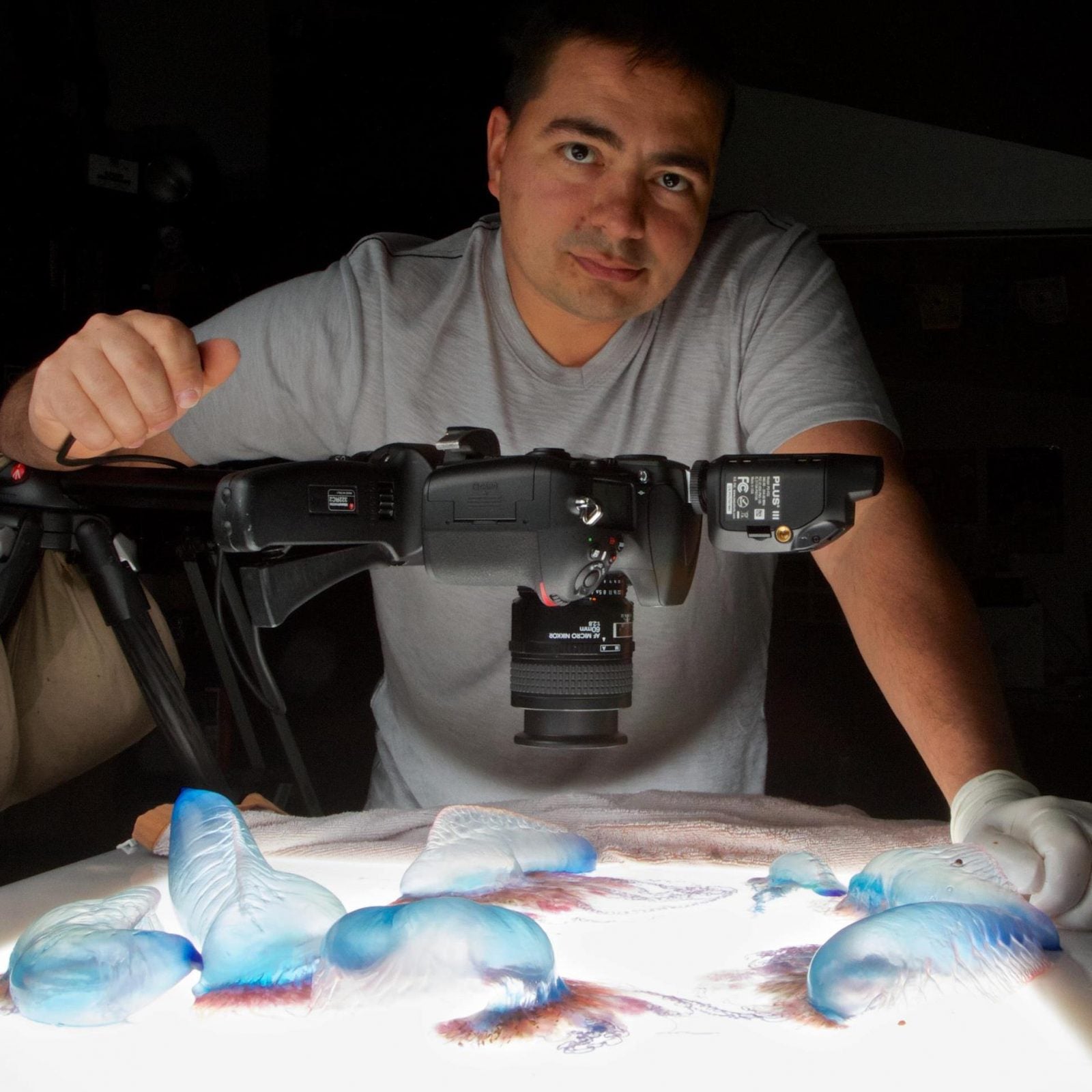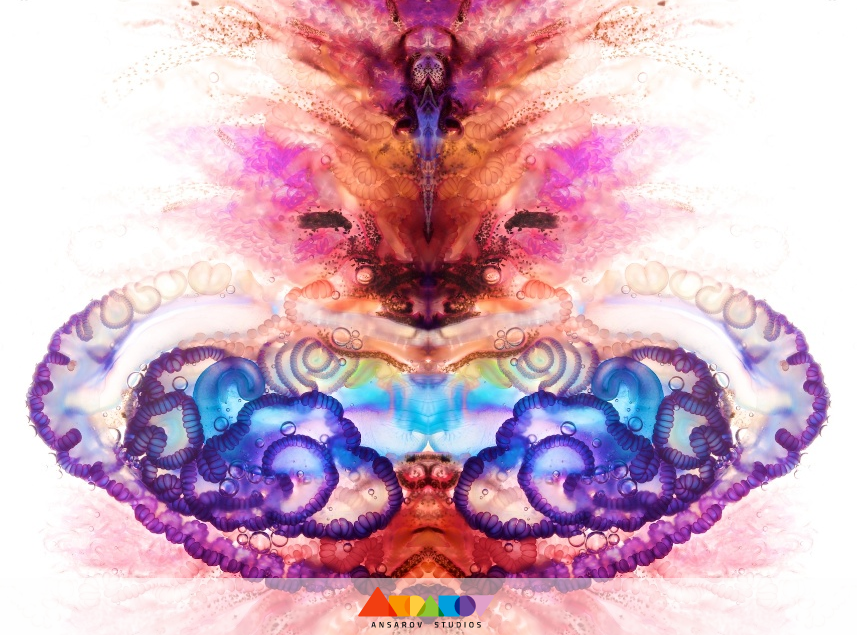You may have seen the work of fine-art macro photographer, Aaron Ansarov, floating around the interwebs lately. Aaron's "Zooids" collection, a body of work created by photographing live Portuguese Man O’ War on a homemade light table, has garnered national attention recently and rightfully so. His images shed new light on these lesser loved creatures, and while most beachgoers avoid and fear them, Aaron's work illustrates just how intricate and beautiful they really are. Aaron was kind enough to share his work with us today and some content from his artist statement. (You can also read about his lighting set up over on the PocketWizard blog!)
About Zooids
"These particular zooids, captured by fine-art macro photographer, Aaron Ansarov, are part of a series of four unique zooids called the dactylozooids (the hunters), gastrozooids (the eaters), gonozooids (the reproducers), and the pneumatophores (the sailors). Each has its individual personality, but collectively exist as a single being with a shared goal of survival. Together, they are more commonly known as the Portuguese Man O’ War. Not much is known about these creatures, other than the fact that they are responsible each year for more than 10,000 documented stings worldwide. But now, for the first time ever, Aaron Ansarov has put faces to these hidden creatures. As if looking through a special lens into a different dimension, Aaron has given them personalities that seem to shift with every viewer. Through Aaron’s masterful use of light, technique, and ability to go beyond the obvious, we are able to see patterns come together to create a fine-art collection of images entitled, Zooids: Faces of Tiny Warriors—beautiful creatures seeking their place in the world.
Behind the Scenes
Aaron begins his day by tracking the weather. Watching the wind forecast and beach conditions report. Bad conditions are good conditions. When the tide is right, Aaron then grabs his family to hit the beach. With empty beer cooler in tow, Aaron drives to the nearby beach where he plays in the sand with his 3 year old daughter and 2 year old son. Meanwhile, his wife, Anna, will don rubber gloves, fill the cooler with ocean water and walk the surf line. With a welcoming smile she walks past the curious beachgoers and searches for the perfect specimens. Once she has collected enough to fill the cooler, she returns to play with the children some more before leaving for the home studio.
Aaron has a light table already setup and ready. After opening the windows for ventilation, he puts on some music and goes to work. Aaron will shoot each Man O’ War for several minutes until he feels he has gotten the shot. Once done, he places them back into the cooler and drives back to the beach. He then will put the Man O’ War back in the general area where they were found.
Zooids Q&A
1. Why did you start photographing these creatures?
This collection is a tangent to my other project titled "My Backyard" where I find, capture, photograph and release creatures of all types and sizes in the areas surrounding my backyard. From that project I have photographed over 150 species which is featured in June’s issue of National Geographic (Photo Journal).
I began photographing these creatures after seeing how fascinating their colors, shapes and textures were. Everyone would see these creatures and look at them in disgust, which made me even more fascinated by them.
2. What interesting fact did you learn about them in the process?
They are actually a colonial organism, which means they are not just one being but four that live harmoniously while sharing a single stomach. It was after discovering this fact that I felt they were showing me faces that I could not recognize until I started mirroring them. Most of us recognize symmetrical objects. It’s in our nature. So by mirroring them I found that magically there appeared to be recognizable objects. Some people immediately would see faces of aliens, demons, and angels while others would see genitalia. It’s fun to watch everyone’s reaction.
3. What’s one thing people should know about them?
Every creature is alive when photographed. My wife and I would go to the beach at certain times of day when the winds and tide were right and the chances were greater to find them. We would make it a family outing. Anna would walk the beach finding perfect specimens. With a little bit of seawater in a beer cooler she would find an average of 5 at a time and we would bring them to our home studio a mile away. After about an hour of shooting, I would bring them back to the same spot and put them back and let nature take it’s course. It is not my place to save these creatures, but I feel I am doing them a great service by giving them a beautiful voice and legacy that will last.
4. How much post processing is done in Photoshop or other software?
My process is simple. Each file is imported into Apple’s Aperture editing program where minor adjustments in exposure, contrast and vibrancy are made. They are then opened in Adobe’s Photoshop program where the only thing that is done is they are copied, pasted and flipped to make the mirror effect.
Some are flipped once to give the face or spider -look while others are flipped a second time to create beautiful patterns. Each image is captured using Nikon’s 36 Megapixel D800 body with a 60mm Micro lens. So the clarity is amazing, but file size tremendous. When mirrored, I am doubling or (in the case of the patterns) quadrupling the file size. This allows me to make 40" x 60" fine art pieces without enlarging them at all.
5. What was the inspiration for your project?
I always believe in seeing with the eyes of a child and in paying special attention to the objects that are commonly overlooked, ignored and cast out. This particular collection spawned from a 6 year long project I began with my oldest son (now 12) photographing creatures like a found object study in my backyard and areas surrounding. So far I have photographed nearly 150 species all captured in the wild, photographed and released unharmed.
6. When did the idea of the light table hit you? Did you try other photography first?
The idea of the light table seemed an obvious one to me. Once I saw the texture and how vibrant the colors where when the light would hit them, I immediately knew this was going to be the correct process. Of course I did try other styles and they look nice, but when the light pushes through, their shapes are further defined and an infinite world is created.
7. So during the whole process, these Man o’ War are alive?
Yes, each creature is alive when we find them, but unfortunately they are in some phase of death, which is why there are some images that are vibrant red and purple, while others look flat orange and brown. My wife is my Man O’ War hunter. We will find the best time to go when the winds and tide are at a peak. Some days she will find and fill the cooler with 5 to 7 and others she won’t find any.
8. And you transport them back to the water alive?
Logistically, how do you handle this? It sounds really tough, and potentially painful. We use a thick rubber gloves, which protects us, but I can’t say it is 100% protective. The tentacles have microscopic needles that sometimes make their way through the gloves. We definitely have been stung a few times.
Once finished shooting, I pack them back in the cooler and bring them back to the beach. I am simply borrowing these creatures and giving them a voice. It would be wrong of me to treat them with any less value as any other creature in the world. Dyeing already or not.
9. What’s the effect you’d like to have on the audience?
Simply put, I want the world to see the universe is in everything. I’m not concerned what higher being a person believes in or calls to (or none at all), but they cannot deny how beautiful and incredibly intricate these (and other) creatures are when we get past our fear and trepidation and see them this close. How can something responsible for thousands of stings around the world each year be so beautiful?
10. Why do you mirror them, rather than showing them asymmetrically?
Most of these images look incredible by themselves, but soon after the first shots I began to notice how air bubbles looked like eyes, and tentacles started looking like facial expressions. So once I began to mirror them once it was as if I revealed faces as clear as day. The more images that I mirrored the more I started noticing more resemblances. The best part was when I started posting them on my Facebook page and everybody would see something different. From faces of monsters to alien vaginas, it’s the new Rorschach test.











